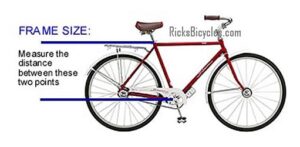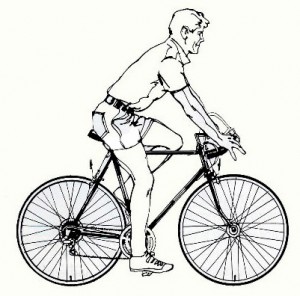Bicycle Frame Sizes and Correct Seat Height
What bicycle size do you need?
Just like shoes, bicycles come in a variety of sizes and styles. Average sized people can ride most model sizes by simply adjusting the seat height—it can be raised or lowered several inches in either direction. These days most riders place their seat height far too low and as a result unknowingly experience an uncomfortable ride and subsequently pedal the bike in an inefficient manner. The proper sized bike frame and seat setting will allow the riders’ legs to be almost fully extended when the pedals are in their lowest position. When this is achieved the rider will also discover the most efficient use of their pedaling efforts and further protect their knees and leg joints from undue strain.
Depending on where and how you measure a bicycle frame, one can get several different measurements from the same bike—making this process more complicated and confusing. Most bicycle manufactures measure the vertical distance between the top of the bicycle seat post tube (frame) to the center of the crank, in the middle of the bottom bracket. See the diagram and photo below. Do not include the seat, seat post or the main frame in the measurement—just the vertical tube itself. A small measurement error could easily yield a difference in one or two inches (2.5 to 3.5 cm). Some manufactures and dealers stop their vertical measurement at the top tube, yielding a shorter number.

Nowadays very few bicycle manufactures build frames in more than one size. In the past, American companies such as Schwinn, Ross and Huffy, built each model of their bicycles in two or more frame sizes. Today, that does not seem to be the case. As an example, nearly all new beach cruiser frames are the same height, about 18 inches. Finding an exact frame size can be difficult. The fix
is very simple—adjust the seat post up or down to make the bicycle size correct for you. Getting on a bicycle and taking a quick test ride can also be of great help. It is without a doubt the best and quickest way of finding and purchasing a bike with a frame size that fits you properly and avoid all the confusion of measuring each and every bicycle you like. Fortunately, bicycles of today have several adjustments available. Simply moving the seat height up or down can correct many riding positions. Further adjustments of the handle bars can also be of great improvements in riding comfort.
When your bicycle seat position is too low, you do not get the full extension of your leg and therefore miss the benefit of the leg-power in your down-stroke movement. In addition a low seat setting can place excessive pressure on your knees making the rider tire-out quicker. Set the seat too high (a rare problem) and while pedaling your hips will rock from side-to-side. When the seat is at the correct height, the rider gains power from less spent effort.
A common mistake for riders is to think they should be able to sit on their bike seat and still plant their feet firmly on the ground—not true! Riders should come off their seat and straddle the bar or frame when stopping the bicycle. If you can sit on the seat and touch your feet to the ground other than using your tippy-toes, your seat is set too low!
To check your seat height, sit on your bicycle with your feet on the pedals, or ride it and take notice. Performing this test while stopped you will need to have a friend hold your bike up-right. When your pedal is at the bottom of its stroke or at the 6 o’clock position, your leg should be extended until it is almost completely straight—there should be only a very slight bend of the knee. See diagram below. If your knee is bent too much, you’ll need to raise your seat height. Following your corrected seat adjustment, the new “feel” for the rider will at first be very different. But give it some time and maybe a few miles and you will soon notice a great improvement in riding comfort, leg power and less fatigue. This adjustment will maximize your power and minimize your riding fatigue.

